
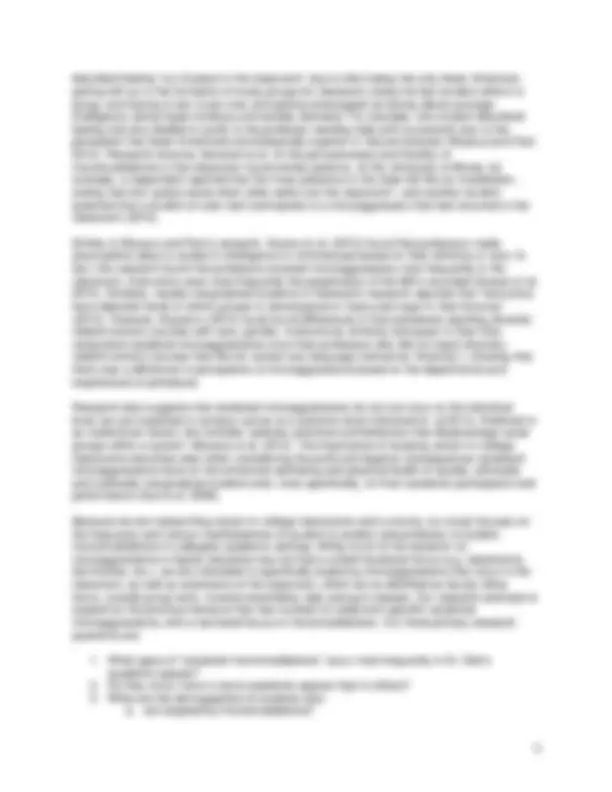
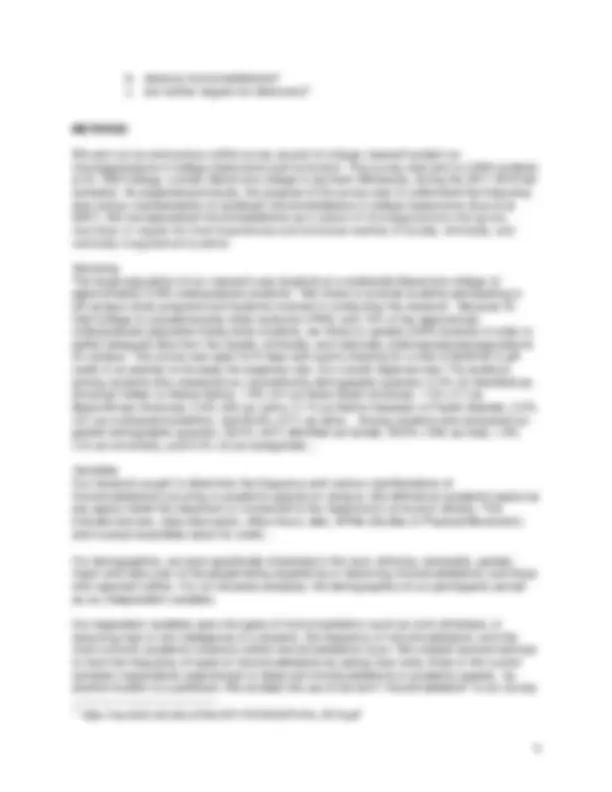
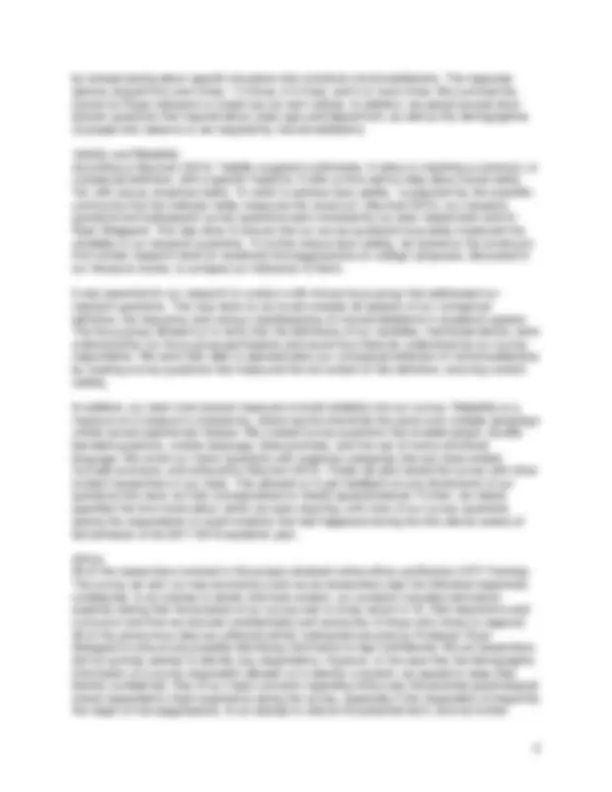
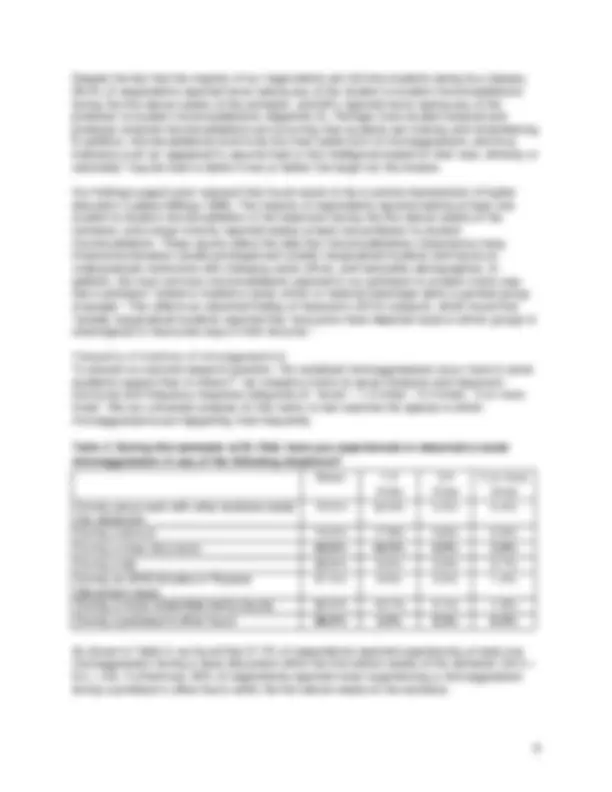
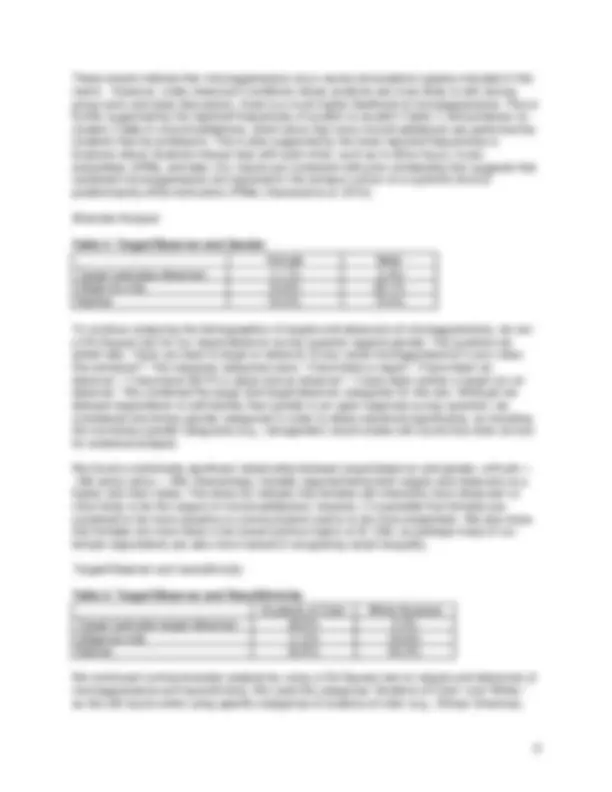
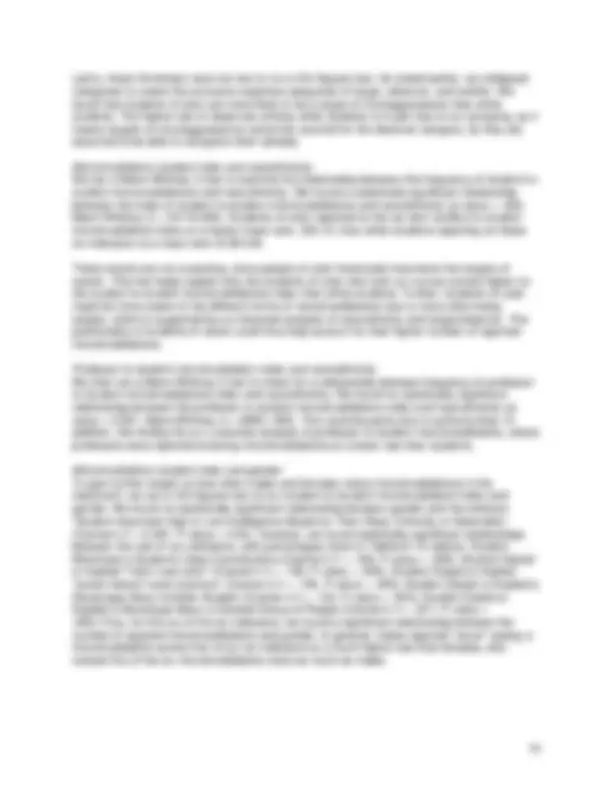
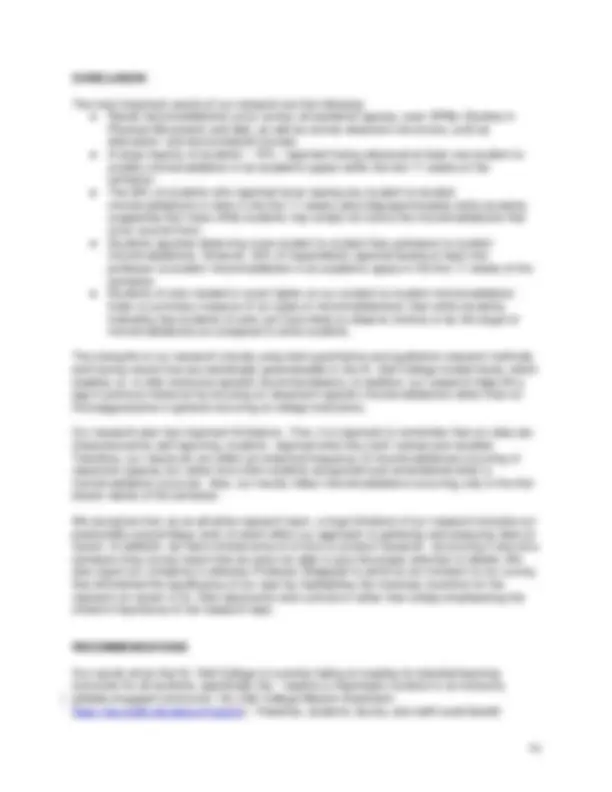





Study with the several resources on Docsity

Earn points by helping other students or get them with a premium plan


Prepare for your exams
Study with the several resources on Docsity

Earn points to download
Earn points by helping other students or get them with a premium plan
Community
Ask the community for help and clear up your study doubts
Discover the best universities in your country according to Docsity users
Free resources
Download our free guides on studying techniques, anxiety management strategies, and thesis advice from Docsity tutors
Insights from a study on microinvalidations in academic spaces, focusing on student-to-student and professor-to-student interactions. The research reveals that a significant number of students have observed microinvalidations, with students of color more likely to be targeted. The document also discusses the importance of educating students and professors on microinvalidations and effective responses.
What you will learn
Typology: Lecture notes
1 / 18

This page cannot be seen from the preview
Don't miss anything!











Microinvalidations in St. Olaf Academic Spaces Rachel Bongart and Juni Lie SOAN 371: Foundations of Social Science Research – Quantitative Methods St. Olaf College - Fall 2017
Executive Summary In the fall of 2017, students in Sociology/Anthropology 371 conducted research on microaggressions in classrooms and the curriculum at St. Olaf College, including their manifestations, impacts, and proactive and retroactive responses. We sent an anonymous online survey to 2,844. We received 718 responses, a 25.2% response rate.
Racism has persisted in our society and institutions despite legal changes aimed at outlawing it. Much contemporary racism occurs in more covert and implicit forms than in the past. Focusing on these contemporary forms, in 1970 Chester Pierce coined the term “racialized microaggressions,” and Sue et al. (2007) later created a typology of its varied forms: microassaults, microinsults, microinvalidations and environmental microaggressions. Our research focuses on the various manifestations and frequencies of microinvalidations in St. Olaf academic spaces. Microinvalidations describe often unconscious microaggressions that ignore, neutralize or negate the lived experiences and emotional realities of racially, ethnically and nationally underrepresented students. Examples include denying white privilege and suggesting that racism doesn’t exist anymore.
The most important results of our research are the following: ● Racial microinvalidations occur across all academic spaces, even SPMs (Studies in Physical Movement) and labs, as well as across classroom structures, such as discussion- and lecture-based courses. ● 72% of students reported having observed at least one student-to-student microinvalidation in an academic space within the first 11 weeks of the semester. ● The 28% of students who reported never seeing any student-to-student microinvalidations in class in the first 11 weeks were disproportionately white students, suggesting that many white students may simply not notice the microinvalidations that occur around them. ● Students reported observing more student-to-student than professor-to-student microinvalidations. However, 35% of respondents reported seeing at least one professor-to-student microinvalidation in an academic space in the first 11 weeks of the semester. ● Students of color tended to score higher on our student-to-student microinvalidation index (a summary measure of six types of microinvalidations) than white students, indicating that students of color are more likely to observe (notice) or be the target of microinvalidations as compared to white students.
Based on our research, we recommend that the college find ways to educate students and professors on microinvalidations and effective ways of responding to them, such as how to challenge racial and ethnic stereotypes when they occur and how to increase consciousness about personal biases (Harwood et al. 2015). Our data and prior scholarship suggest that microinvalidations occur more often than many white students realize; this could include the microinvalidations they themselves perpetrate. Our data also suggest that microinvalidations are enacted by students and professors alike. Therefore, we recommend that the college add in- depth education on microaggressions to supplement the current education on diversity and inclusion, such as Diversity.edu and Sustained Dialogues.
In the United States, racism is traditionally considered to be overt, explicit and intentional. Despite legal changes that have supposedly outlawed racism, it has endured in more covert and implicit forms. According to Museus and Park (2015), overt racism can manifest as violent hate crimes, such as physical abuse, damage to property or offensive language. In contrast, according to Harwood et al. (2015), covert racism can manifest on a daily basis, such as failing to recognize race, ethnicity and nationality, with color-blind remarks like “I don’t see race”. Although overt forms of racism are by no means absent from society, it is the more subtle yet commonplace forms of racism that hinder racism at large from being addressed effectively by society. This is because covert racism is often committed unconsciously by the perpetrator and masked by aggressions that may not be considered racist, such as racial stereotyping (Harper 2012).
As forms of racism have changed, Critical Race Theory scholars have developed new language to analyze contemporary manifestations of racism. Psychiatrist and professor Chester Pierce coined the term racialized microaggressions (1974) to describe modern-day racism in the United States that encompasses behavioral, verbal or environmental insults regarding race that can be intentional or unintentional, conscious or unconscious, overt or covert (Minikel-Lacocque 2013). Sue et al. expanded on this term to create a typology of three different forms of racialized microaggressions: microassaults, microinsults and microinvalidations (2007). Microassaults are verbal or nonverbal derogatory racial attacks, often intended to be harmful, such as using a racial slur to address a racially, ethnically or nationally marginalized person or wearing a t-shirt with the Confederate flag on it. Microinsults include statements or actions, often unintentional, that degrade, belittle or tokenize a person’s racial, ethnic or national identity, such as assuming that a certain racial group is inherently violent. Lastly, microinvalidations , which are the focus of our research, are often unconscious microaggressions that ignore, neutralize or negate the experiences and emotional realities of racially, ethnically, and nationally marginalized students; examples include denying white privilege and stating or implying that racism doesn’t exist anymore (Sue et al. 2007). However, current research cautions us to acknowledge that the term “microaggressions” in and of itself is faulty. Because “micro” indicates something small and insignificant, the term in some ways retracts from its original conception as elusive but insidious. The very fact that it is hard to name and hard to see makes it more powerful. Ultimately, it is the cumulative burden of these quiet, racist acts on their targets that makes their impacts so severe (Pierce 1995).
Researchers have found that racialized microaggressions occur in many settings, including academic institutions. Critical Race Theory considers racism to be a central characteristic of higher education (Ladson-Billings 1998). For example, many scholars of color are left out of course curriculum or, if included, are tokenized for their race or framed as an alternative perspective. Because of the changing racial, ethnic and national demographics in the last half century at predominantly white colleges in the United States, racialized microaggressions increasingly characterize interactions between marginalized and non-marginalized students and faculty. Our research specifically examines the various manifestations and frequencies of student-to-student and professor-to-student racialized microinvalidations.
In their studies on microaggressions in college classrooms, both Museus and Park (2015) and Harwood et al. (2015) found that student-to-student microinvalidations are more likely to occur when an ethnically, racially or nationally marginalized student is the only member of their ethnic, racial or national group in an academic space. Museus and Park investigated microinvalidations in the classroom and their impacts on Asian American students. In particular, students
b. observe microinvalidations? c. are neither targets nor observers?
We sent out an anonymous online survey as part of a larger research project on microaggressions in college classrooms and curriculum. This survey was sent to 2,844 students at St. Olaf College, a small, liberal arts college in southern Minnesota, during the 2017-2018 fall semester. As explained previously, the purpose of the survey was to understand the frequency and various manifestations of racialized microinvalidations in college classrooms (Sue et al. 2007). We conceptualized microinvalidations as a subset of microaggressions that ignore, neutralize or negate the lived experiences and emotional realities of racially, ethnically, and nationally marginalized students.
Sampling The target population of our research was students at a residential liberal arts college of approximately 3,040 undergraduate students.^1 We chose to exclude students participating in off-campus study programs and students involved in conducting this research. Because St. Olaf College is a predominantly white institution (PWI), with 74% of the approximate undergraduate population being white students, we chose to sample 2,844 students in order to gather adequate data from the racially, ethnically, and nationally underrepresented populations on campus. The survey was open for 9 days and used a drawing for a total of $400.00 in gift cards in an attempt to increase the response rate. Our overall response was 718 students; among students who answered our race/ethnicity demographic question, 0.4% (3) identified as American Indian or Alaska Native, 7.9% (57) as Asian/Asian-American, 1.5% (11) as Black/African-American, 2.8% (20) as Latinx, 0.1% as Native Hawaiian or Pacific Islander, 5.2% (37) as multiracial/multiethnic, and 65.6% (471) as white.. Among students who answered our gender demographic question, 59.5% (427) identified as female, 29.0% (183) as male, 1.9% (14) as non-binary, and 0.4% (3) as transgender...
Variables Our research sought to determine the frequency and various manifestations of microinvalidations occurring in academic spaces on campus. We defined an academic space as any space inside the classroom or connected to the classroom’s curriculum directly. This includes lectures, class discussion, office hours, labs, SPMs (Studies in Physical Movement), and musical ensembles taken for credit. :
For demographics, we were specifically interested in the race, ethnicity, nationality, gender, major and class year of the people being targeted by or observing microinvalidations, and those who reported neither. For our bivariate analyses, the demographics of our participants served as our independent variables.
Our dependent variables were the types of microinvalidation (such as color blindness, or assuming high or low intelligence of a student), the frequency of microinvalidations , and the most common academic locations where microinvalidations occur. We created several matrices to track the frequency of types of microinvalidations by asking how many times in the current semester respondents experienced or observed microinvalidations in academic spaces, by another student or a professor. We avoided the use of the term “microinvalidation” in our survey
(^1) https://wp.stolaf.edu/about/files/2017/02/StOlafProfile_2016.pdf
by instead asking about specific situations that constitute microinvalidations. The response options ranged from zero times, 1-2 times, 3-4 times, and 5 or more times. We summed the scores for these indicators to create two six-item indices. In addition, we asked several short answer questions that inquired about class type and department, as well as the demographics of people who observe or are targeted by microinvalidations.
Validity and Reliability According to Neuman (2012) “Validity suggests truthfulness. It refers to matching a construct, or conceptual definition, with a specific measure. It tells us how well an idea about social reality ‘fits’ with actual, empirical reality.” In order to achieve face validity, “a judgment by the scientific community that the indicator really measures the construct” (Neuman 2012), our research questions and subsequent survey questions were reviewed by our peer researchers and Dr. Ryan Sheppard. This was done to ensure that our survey questions accurately measured the variables in our research questions. To further ensure face validity, we looked at the constructs from similar research done on racialized microaggressions on college campuses, discussed in our literature review, to compare our indicators to theirs.
It was essential for our research to conduct a 90-minute focus group that addressed our research questions. This was done so we could consider all aspects of our conceptual definition: the frequency and various manifestations of microinvalidations in academic spaces. The focus group allowed us to verify that the definitions of our variables, mentioned above, were understood by our focus group participants and would thus likely be understood by our survey respondents. We were then able to operationalize our conceptual definition of microinvalidations by creating survey questions that measured the full content of this definition, ensuring content validity.
In addition, our team took several measures to build reliability into our survey. Reliability is a measure of a measure’s consistency, where results should be the same over multiple samplings unless actual experiences change. We created survey questions that avoided jargon, double- barreled questions, unclear language, false premises, and the use of overly emotional language. We wrote our matrix questions with response categories that are close-ended, mutually exclusive, and exhaustive (Neuman 2012). Finally we pilot-tested the survey with other student researchers in our class. This allowed us to get feedback on any dimensions of our questions that were not fully conceptualized or clearly operationalized. Further, we clearly specified the time frame about which we were inquiring, with most of our survey questions asking the respondents to recall incidents that had happened during the first eleven weeks of fall semester of the 2017-2018 academic year.
Ethics All of the researchers involved in this project obtained online ethics certification (CITI Training). The survey we sent out was anonymous and we as researchers kept the individual responses confidential. In an attempt to obtain informed consent, our invitation included information explicitly stating that the purpose of our survey was to study racism in St. Olaf classrooms and curriculum and that we ensured confidentiality and anonymity of those who chose to respond. All of the anonymous data we collected will be maintained securely by Professor Ryan Sheppard to ensure any possible identifying information is kept confidential. We as researchers did not actively attempt to identify any respondents. However, in the case that the demographic information of a survey respondent allowed us to identify a student, we agreed to keep their identity confidential. One of our major concerns regarding ethics was the potential psychological stress respondents might experience taking the survey, especially if the respondent is frequently the target of microaggressions. In an attempt to reduce the potential harm, and not further
“never” for all items. Additionally, 14% reported seeing five of the six microinvalidation indicators at least once in the first eleven weeks of the semester (see Appendix A). The indicator that students reported least, with 76% reporting “never,” was noticing a fellow student state or imply that “racism doesn’t exist anymore.”
Professor-to-student microinvalidations To examine professor-to-student microinvalidations, we created a parallel matrix of six indicators with frequency response categories of “never,” “1-2 times”, “3-4 times,” “5 or more times,” using the survey question for the, “Think about this semester at St. Olaf, during your classes: How many times have you observed a professor do the following things towards you or another student?” We ran univariate analysis on this matrix to test the frequency of each type of professor-enacted microinvalidation in St. Olaf classrooms.
Table 2. Professor-to-Student Microinvalidation Frequencies
Never 1 - 2 times
times
5 or more times Minimized a student’s comments or contributions because of their race, ethnicity, or nationality
Stated or implied “I don’t see color” regarding race and ethnicity
Stated or implied that “racism doesn’t exist anymore”
Stated or implied a racial, ethnic, or national stereotype that targeted a student in the class
Stated or implied a racial, ethnic, or national stereotype about a general group of people
Appeared to assume a student has high or low intelligence based on their race, ethnicity, or nationality (such as acting surprised when a person of color does well on an exam or assuming they will perform well on technical tasks)
As shown in Table 2, we found that 93.2% of respondents reported that they had not observed hearing a professor state or imply that “racism doesn’t exist anymore” within the first eleven weeks of the semester. Additionally, respondents reported fewer microaggressions from professors than from students. This could perhaps be due to authority bias in professor-student interactions in the classroom, meaning that students are less likely to report microaggressions performed by professors due to a power dynamic that makes students less inclined to critically analyze statements made by professors.
More than one-quarter of students reported that they observed a professor stating or implying “a racial, ethnic, or national stereotype about a general group of people (27.9%, or 20.5 + 4.7 + 2.7)” As with many of our results, it is important to remember that students were reporting what they both noticed and recalled. Therefore, our results do not reflect an empirical frequency of microinvalidations occurring in classroom spaces, but rather how often students recognized and remembered when a microinvalidation occurred. The most common form of microinvalidations reported in both the professor-to-student and student-to-student matrices was when a professor or student ”stated or implied a racial, ethnic or national stereotype about a general group of people.”
Despite the fact that the majority of our respondents are full-time students taking four classes, 28.2% of respondents reported never seeing any of the student-to-student microinvalidations during the first eleven weeks of the semester, and 65% reported never seeing any of the professor-to-student microinvalidations (Appendix A). Perhaps more student-enacted and professor-enacted microinvalidations are occurring than students are noticing and remembering. In addition, microinvalidations tend to be the most subtle form of microaggression, and thus indicators such as “appeared to assume high or low intelligence based on their race, ethnicity or nationality” may be hard to detect if one is neither the target nor the enactor.
Our findings support prior research that found racism to be a central characteristic of higher education (Ladson-Billings 1998). The majority of respondents reported seeing at least one student-to-student microinvalidation in the classroom during the first eleven weeks of the semester, and a large minority reported seeing at least one professor-to-student microinvalidation. These results reflect the idea that microinvalidations characterize many interactions between racially privileged and racially marginalized students and faculty at undergraduate institutions with changing racial, ethnic, and nationality demographics. In addition, the most common microinvalidation reported in our professor-to-student matrix was that a professor “stated or implied a racial, ethnic or national stereotype about a general group of people.” This reflects an essential finding of Harwood’s (2015) research, which found that “racially marginalized students reported that ‘instructors have depicted racial or ethnic groups in stereotypical or inaccurate ways in their lectures’.”
Frequency of locations of microaggressions To answer our second research question, “Do racialized microaggressions occur more in some academic spaces than in others?,” we created a matrix of seven locations and classroom structures with frequency response categories of: “never”, “1-2 times”, “3-4 times”, “5 or more times”. We ran univariate analysis on this matrix to test examine the spaces in which microaggressions are happening most frequently.
Table 3. During this semester at St. Olaf, have you experienced or observed a racial microaggression in any of the following situations?
Never 1 - 2 times
times
5 or more times During group work with other students inside the classroom
During a lecture 74.5% 17.8% 5.6% 2.0% During a class discussion 62.8% 24.5% 9.2% 3.6% During a lab 88.8% 8.5% 2.0% 0.7% During an SPM (Studies in Physical Movement class)
During a music ensembles led by faculty 82.3% 10.7% 5.1% 1.9% During a professor's office hours 96.0% 3.5% 0.3% 0.2%
As shown in Table 3, we found that 37.3% of respondents reported experiencing at least one microaggression during a class discussion within the first eleven weeks of the semester (24.5 + 9.2 + 3.6). Furthermore, 96% of respondents reported never experiencing a microaggression during a professor’s office hours within the first eleven weeks of the semester.
Latinx, Asian American) were too low to run a Chi-Square test. As stated earlier, we collapsed categories to create the exclusive response categories of target, observer, and neither. We found that students of color are more likely to be a target of microaggressions than white students. The higher rate of observers among white students is in part due to our grouping, as it means targets of microaggressions cannot be counted for the observer category, as they are assumed to be able to recognize them already.
Microinvalidation student index and race/ethnicity We ran a Mann-Whitney U test to examine the relationship between the frequency of student-to- student microinvalidations and race/ethnicity. We found a statistically significant relationship between the index of student-to-student microinvalidations and race/ethnicity (p-value = .002, Mann-Whitney U = 24116.500). Students of color reported on the six-item student-to-student microinvalidation index at a higher mean rank, 335.10, than white students reporting on these six indicators at a mean rank of 284.09.
These results are not surprising, since people of color historically have been the targets of racism. This fact helps explain why the students of color who took our survey scored higher on the student-to-student microinvalidations index than white students. Further, students of color might be more aware of the different forms of microinvalidations due to more often being targets, which is supported by our bivariate analysis of race/ethnicity and target/observer. The positionality of students of colors could thus help account for their higher number of reported microinvalidations.
Professor-to-student microinvalidation index and race/ethnicity We then ran a Mann-Whitney U test to check for a relationship between frequency of professor- to-student microinvalidations index and race/ethnicity. We found no statistically significant relationship between the professor-to-student microinvalidations index and race/ethnicity (p- value = 0.097, Mann-Whitney U = 26851.000). This could be partly due to authority bias. In addition, this finding fits our univariate analysis of professor-to-student microinvalidations, where professors were reported enacting microinvalidations at a lower rate than students.
Microinvalidation student index and gender To gain further insight on how often males and females notice microinvalidations in the classroom, we ran a Chi-Square test of our student-to-student microinvalidation index and gender. We found no statistically significant relationship between gender and the indicator “Student Assumed High or Low Intelligence Based on Their Race, Ethnicity or Nationality” (Cramer’s V = 0.097, P-value = 0.05). However, we found statistically significant relationships between the rest of our indicators, with percentages show in Tables 6-10, below): Student Minimized a Student’s Class Contributions (Cramer’s V = .186, P-value = .000); Student Stated or Implied “I don’t see color” (Cramer’s V = .136, P-value = .003); Student Stated or Implied “racism doesn’t exist anymore” (Cramer’s V = .136, P-value = .003); Student Stated or Implied a Stereotype About Another Student (Cramer’s V = .134, P-value = .003); Student Stated or Implied a Stereotype About a General Group of People (Cramer’s V = .247, P-value = .000).Thus, for five out of the six indicators, we found a significant relationship between the number of reported microinvalidations and gender. In general, males reported “never” seeing a microinvalidation across five of our six indicators at a much higher rate than females, who noticed five of the six microinvalidations twice as much as males.
Table 6. Student Minimized Another Student’s Class Contributions
Female Male Never 62.0% 80.2% 1 - 2 times 31.4% 15.0% 3 or more times 6.6% 4.8%
Table 7. Student Stated or Implied “I don’t see color”
Female Male Never 62.6% 75.4% 1 - 2 times 27.8% 15.9% 3 or more times 9.6% 8.7%
Table 8. Student Stated or Implied “racism doesn’t exist anymore”
Female Male Never 73.5% 85.6% 1 - 2 times 20.6% 11.5% 3 or more times 5.9% 2.9%
Table 9. Student Stereotyped Another Student
Female Male Never 62.8% 76.0% 1 - 2 times 26.9% 16.3% 3 or more times 10.3% 7.7%
Table 10. Student Stereotyped a General Group of People
Female Male Never 32.8% 58.7% 1 - 2 times 44.1% 27.9% 3 or more times 23.1% 13.5%
MI professor index and gender We found statistically significant relationships between gender and two of the professor-to- student microinvalidation indicators: professor minimized a student’s class contribution (Cramer’s V = .133, P-value = .004), and professor stated a stereotype about a general group of people (Cramer’s V = .194, P-value = .00). In both cases, female students were more likely than male students to report microinvalidations, as shown in Tables 11 and 12, below.
Table 11. Professor Stated a Stereotype About a General Group of People
Female Male Never 67.1% 85.4% 1 - 2 times 24.9% 10.2% 3 or more times 8.0% 4.4%
The most important results of our research are the following: ● Racial microinvalidations occur across all academic spaces, even SPMs (Studies in Physical Movement) and labs, as well as across classroom structures, such as discussion- and lecture-based courses. ● A large majority of students – 72% - reported having observed at least one student-to- student microinvalidation in an academic space within the first 11 weeks of the semester. ● The 28% of students who reported never seeing any student-to-student microinvalidations in class in the first 11 weeks were disproportionately white students, suggesting that many white students may simply not notice the microinvalidations that occur around them. ● Students reported observing more student-to-student than professor-to-student microinvalidations. However, 35% of respondents reported seeing at least one professor-to-student microinvalidation in an academic space in the first 11 weeks of the semester. ● Students of color tended to score higher on our student-to-student microinvalidation index (a summary measure of six types of microinvalidations) than white students, indicating that students of color are more likely to observe (notice) or be the target of microinvalidations as compared to white students.
The strengths of our research include using both quantitative and qualitative research methods and having results that are statistically generalizable to the St. Olaf College student body, which enables us to offer institution-specific recommendations. In addition, our research helps fill a gap in previous literature by focusing on classroom-specific microinvalidations rather than on microaggressions in general occurring at college institutions.
Our research also has important limitations. First, it is important to remember that our data are characterized by self-reporting; students reported what they both noticed and recalled. Therefore, our results do not reflect an empirical frequency of microinvalidations occurring in classroom spaces, but rather how often students recognized and remembered when a microinvalidation occurred. Also, our results reflect microinvalidations occurring only in the first eleven weeks of the semester.
We recognize that, as an all-white research team, a huge limitation of our research includes our positionality and privilege, both of which affect our approach to gathering and analyzing data on racism. In addition, we had a limited amount of time to conduct research; structuring it around a semester long course meant that we were not able to give the proper attention to details. We also regret our complicity in allowing Professor Sheppard to send out an invitation to our survey that diminished the significance of our topic by highlighting the monetary incentive for the research on racism in St. Olaf classrooms and curriculum rather than simply emphasizing the inherent importance of the research topic.
Our results show that St. Olaf College is currently failing at meeting its intended learning outcomes for all students, specifically the : “explore a meaningful vocation in an inclusive, globally engaged community” (St. Olaf College Mission Statement; https://wp.stolaf.edu/about/mission/). Therefore, students, faculty, and staff could benefit
significantly from education regarding microaggressions in the classroom. This new education should more adequately address institutional racism than current educational efforts. Our research team recognizes that current efforts - such as Diversity.edu and Sustained Dialogues at St. Olaf College - are in place, but we recommend the following characteristics for future education.
For students, we recommend that the college provide education on microaggressions that explicitly addresses racism as a power structure. Many white students indicated in the open response answers that they wished they had the discursive tools to discuss and recognize in- class microaggressions. For example, “Filling out this survey, I realize I haven’t been aware of many microaggressions in my classes, but I know they do happen and have had to talk to people outside of classes...instead.” This is also indicated by the discrepancy between the percentage of white students versus students of color who reported witnessing microaggressions.. Ideally, this education would include material that helps students recognize power dynamics and the personal biases that they may have.
For faculty and staff, we recommend that there be mandatory or highly-incentivized training that encourages them to recognize their own biases and positionality. Ideally, this training would also encourage professors to address microaggressions and stereotyping as they happen, in a productive, direct manner. This education would additionally guide faculty and staff on how to work through the tensions that may arise when stereotyping and microaggressions are discussed.